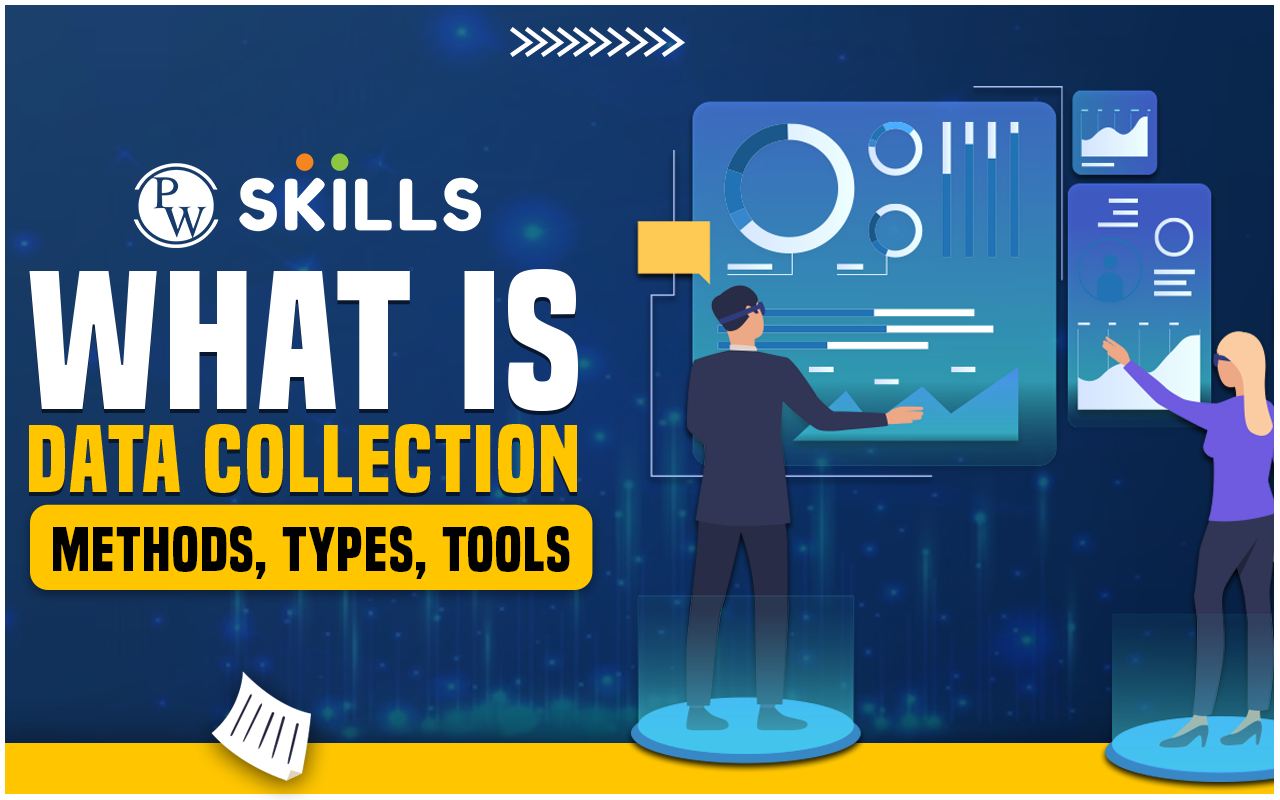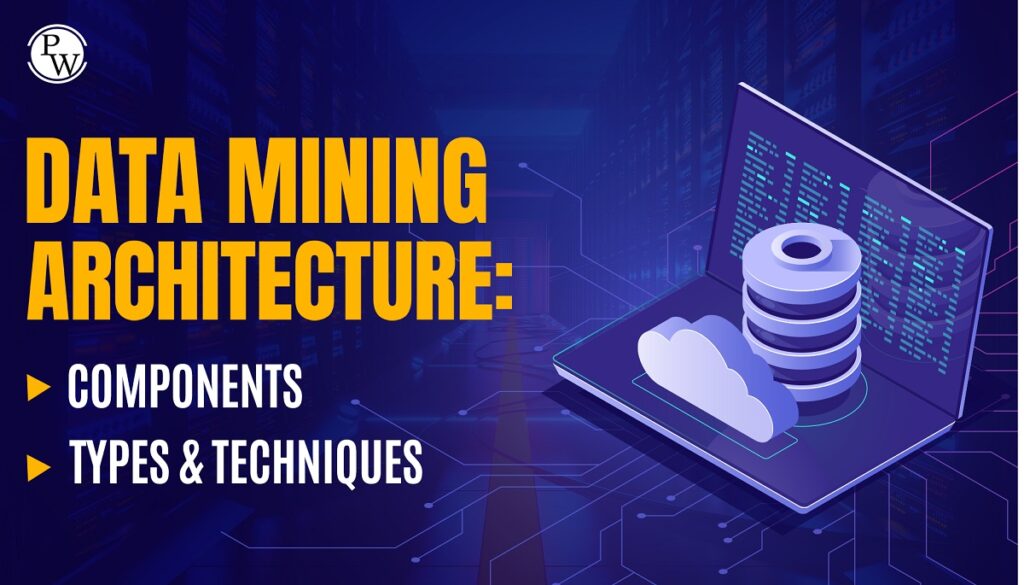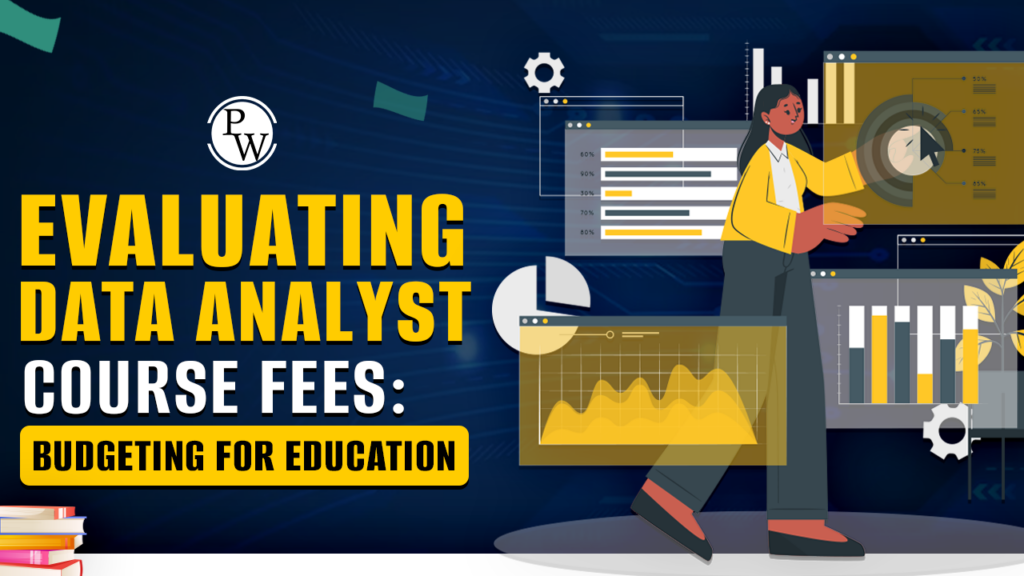Data Collection: In the rapidly evolving landscape of information and technology, the role of data has become increasingly pivotal. Whether in business, academia, or everyday decision-making, the need for accurate and reliable data has never been more crucial. In this blog, we’ll talk about data collection, its types, methods, tools, and much more!
If you want to start a successful career in data analytics, then enroll in PhysicsWallah’s Mastering Full Stack Data Analytics Course. Learn from industry experts, gain hands-on experience, and open doors to exciting career opportunities. Enroll today and become a data analytics master!
What is Data Collection?
Data collection is fundamentally systematically gathering information for analysis and interpretation. It spans various fields, serving as the foundation for informed decision-making. From identifying consumer trends in marketing to advancing scientific research, the applications of data collection are vast and varied.
Types of Data Collection
Data collection is a nuanced process, and understanding the types of data involved is pivotal for researchers and decision-makers. It encompasses both primary and secondary data, each offering unique insights and posing specific challenges.
Primary Data
- Surveys and Questionnaires:
-
-
- Definition and Examples: Surveys and questionnaires involve the systematic collection of data through structured questions, often distributed to a large sample. Examples include customer satisfaction surveys, market research questionnaires, and demographic surveys.
- Advantages: Enables the collection of standardised data from a diverse audience. Facilitates quantitative analysis and statistical inference.
- Disadvantages: Potential for response bias, limited depth of information, and challenges in designing unbiased questions.
-
- Interviews:
-
-
- Types of Interviews: Interviews are either of these three – structured, semi-structured, or unstructured types. Structured ones stick to predetermined questions, whereas semi-structured and unstructured interviews offer a more conversational and exploratory approach.
- Pros and Cons: These interviews delve deep into individual views and experiences. They take time, need skilled interviewers, and may be biassed.
-
- Observations:
-
- Participant vs. Non-participant Observations: In participant observation, the researcher actively engages in the setting. Non-participant observation keeps a more distant role. It’s common in ethnographic studies and behavioural research.
- Ethical standards: These are crucial, especially in participant observation, where the researcher is deeply involved in the subjects’ environment.
Secondary Data
- Definition and Examples:
-
-
- Secondary data involves the use of existing information gathered by others for purposes other than the current research or analysis. Examples include government reports, academic journals, historical records, and databases.
- Sources and Limitations: Secondary data can be sourced from a variety of outlets, such as archives, libraries, and online repositories. Limitations include potential outdatedness, relevance issues, and lack of control over data collection methods.
-
- Advantages and Disadvantages of Secondary Data:
-
- Advantages: Cost-effective, time-saving, and can provide historical context. Useful for large-scale studies and trend analysis.
- Disadvantages: Lack of control over data quality, potential for bias in the original data collection, and limitations in addressing specific research questions.
Also read: Top 10 Data Analytics Trends to Watch Out for in 2024
Data Collection in Research
Research is a domain where data collection takes centre stage. It involves a meticulous process of defining research objectives, selecting appropriate data collection methods, and executing them effectively. Whether conducting experiments, surveys, or case studies, the quality of data collected plays a decisive role in the validity and reliability of research findings.
Why Do We Need Data Collection?
Collecting data goes beyond just gathering information; it’s essential for making decisions. In business, data is crucial for analysing markets, creating customer profiles, and planning strategies. In healthcare, it underpins medical research, patient care, and epidemiological studies. Essentially, data collection provides the raw material for building insights and making informed choices.
What Are the Different Data Collection Methods?
Methods for collecting data are varied and adaptable, customised for the unique needs and goals of a research study or analysis. It’s vital for researchers to comprehend the subtleties of each method to choose the most fitting one for their inquiries. Here are the three main categories of data collection methods:
Quantitative Data Collection:
Quantitative methods involve the collection of numerical data, enabling statistical analysis and the identification of patterns, trends, and relationships. This approach is particularly useful when seeking to measure and quantify variables with precision. Common quantitative data collection methods include:
Surveys and Questionnaires:
– Surveys are structured sets of questions administered to a sample population.
– Questionnaires can be distributed electronically or on paper, allowing for standardised data collection.
Experiments:
– Experimental designs involve manipulating variables to observe their effects on an outcome.
– Randomized control trials (RCTs) are a common experimental method in scientific research.
Observational Studies:
– Systematic observation of subjects in their natural environment.
– Provides insights into behavior’s, interactions, and occurrences.
Structured Interviews:
– Interviews with predetermined questions and response categories.
– Facilitates standardised data collection for analysis.
Qualitative Data Collection:
Qualitative methods, in contrast, focus on gathering non-numerical data to explore the depth and complexity of human experiences, attitudes, and behavior’s. This approach is invaluable for gaining insights into the meanings and motivations behind observable phenomena. Key qualitative data collection methods include:
In-depth Interviews:
– Open-ended conversations allowing for a deep exploration of a participant’s perspectives.
– Unstructured or semi-structured formats enhance flexibility.
Focus Groups:
– Group discussions involving a small number of participants.
– Encourages interaction and the exploration of shared experiences and opinions.
Participant Observation:
– Researchers actively engage with and observe participants in their natural settings.
– Immersive approach to understanding social and cultural contexts.
Content Analysis:
– Systematic analysis of textual, visual, or audio content to identify patterns and themes.
– Used for studying media, documents, or communication.
Mixed-Methods Approach:
Recognizing the strengths of both quantitative and qualitative methods, researchers often opt for a mixed-methods approach. This involves integrating elements of both approaches in a single study to provide a more comprehensive understanding. The key components of a mixed-methods approach include:
Sequential Exploratory Design:
– Initial qualitative data collection and analysis inform the design of quantitative data collection.
– Qualitative insights guide the development of quantitative surveys or experiments.
Convergent Design:
– Simultaneous collection of both quantitative and qualitative data.
– Allows for comparison and validation of findings from the two approaches.
Explanatory Design:
– Initial quantitative data collection followed by qualitative data collection to explain and enhance the quantitative results.
– Qualitative insights provide context and depth to quantitative findings.
Data Collection Tools
Technology progress has brought forth a new age of data collection tools. Online platforms enable the administration of surveys and questionnaires, simplifying the process and expanding the reach to a broader audience. Interviews are facilitated by video conferencing software, breaking down geographical barriers. Observation tools may include video recording devices and specialised software for automated data logging.
Also read: Essential Data Analytics Tools for Successful Analysis
The Importance of Ensuring Accurate and Appropriate Data Collection
The integrity of the data collected is paramount. Inaccurate or inappropriate data can lead to flawed analyses and misguided decisions. Ensuring accuracy involves rigorous planning, careful execution, and continuous quality control throughout the data collection process. Moreover, the relevance and appropriateness of the data collected must align with the research objectives to yield meaningful insights.
Issues Related to Maintaining the Integrity of Data Collection
Maintaining the integrity of data collection involves navigating ethical considerations, addressing privacy concerns, and implementing robust data security measures. However, ethical challenges may surface, especially when handling sensitive information or vulnerable groups. It’s crucial to protect privacy to establish trust with participants, and robust security measures are necessary to prevent data breaches.
What are Common Challenges in Data Collection?
Despite the advancements in data collection methods and tools, challenges persist. Participant cooperation can be a hurdle, affecting the quality and completeness of the data gathered. Sampling issues, such as selection bias, can introduce distortions in the findings. Data quality control is an ongoing challenge, requiring meticulous attention to detail to identify and rectify errors.
What are the Key Steps in the Data Collection Process?
Effective data collection is a systematic and well-planned process that involves several key steps to ensure the reliability and validity of the gathered information. Each step plays a crucial role in shaping the overall success of the data collection endeavor.
-
- Planning and Design:
- Define Objectives: Clearly articulate the research or project objectives. What specific information do you need to gather, and how will it contribute to your goals?
- Select Data Collection Methods: Based on the objectives, choose the most appropriate data collection methods—whether surveys, interviews, observations, or a combination of approaches.
- Design Instruments: Develop the tools required for data collection, such as survey questionnaires, interview scripts, or observation protocols. Ensure clarity and consistency in language and format.
- Pilot Testing:
- Test Instruments: Before launching the full-scale data collection, conduct a pilot test with a small sample. This helps identify any ambiguities or issues with the instruments.
- Refinement: Use feedback from the pilot test to refine and improve the instruments. Address any confusing or ambiguous questions and make necessary adjustments.
- Actual Data Collection:
- Recruitment and Sampling: Implement the planned sampling strategy. Whether through random sampling, stratified sampling, or other methods, ensure that your sample is representative of the population of interest.
- Training: If data collectors are involved, provide comprehensive training on the data collection process, instruments, and ethical considerations.
- Data Collection Execution: Execute the data collection plan systematically and consistently. Adhere to the established protocols to maintain uniformity in the data-gathering process.
- Data Analysis and Interpretation:
- Data Cleaning: Before analysis, thoroughly review collected data for completeness and accuracy. Address any missing or inconsistent entries.
- Quantitative Analysis: For quantitative data, employ statistical methods to analyse patterns, relationships, and trends.
- Qualitative Analysis: Qualitative data may involve coding and thematic analysis to derive meaningful insights.
- Interpretation: Interpret the analysed data in the context of your research objectives. What do the findings reveal, and how do they contribute to your overarching goals?
- Documentation and Reporting:
- Document the Process: Maintain detailed records of the entire data collection process, including any deviations from the original plan and unexpected challenges.
- Prepare Reports: Present the findings in a clear and concise manner. Use visual aids, charts, and graphs to enhance understanding.
- Draw Conclusions: Summarise the key conclusions drawn from the data analysis. Discuss implications and potential applications of the findings.
- Feedback and Iteration:
- Seek Feedback: Encourage feedback from stakeholders, team members, or experts in the field. External perspectives can provide valuable insights.
- Iterate if Necessary: If feedback suggests areas for improvement or if unexpected issues arise, be willing to iterate on the data collection process. Continuous improvement is a hallmark of effective research.
- Ethical Considerations:
- Informed Consent: Ensure that participants are fully informed about the nature of the study and provide voluntary consent to participate.
- Privacy Protection: Implement measures to protect the privacy of participants. Anonymize data when necessary, and store it securely.
- Respect and Integrity: Uphold the ethical principles of respect, integrity, and fairness throughout the data collection process.
- Quality Control:
- Regular Checks: Establish checkpoints for quality control during the data collection phase. Monitor the process to identify and rectify any deviations from the plan.
- Data Validation: Implement mechanisms for data validation to catch errors or inconsistencies in real-time.
- Adaptation and Flexibility:
- Be Adaptable: Acknowledge that no plan is foolproof. Be ready to adapt to unforeseen circumstances and challenges.
- Flexibility in Approach: If initial data collection reveals the need for adjustments in the research design or methods, be open to modifying the approach for the sake of data quality.
- Planning and Design:
- Post-Collection Reflection:
-
- Reflect on the Process: After data collection is complete, reflect on the overall process. What worked well, and what could be improved for future projects?
- Lessons Learned: Document lessons learned and insights gained during the data collection process. This reflection contributes to the continuous improvement of future research endeavors.
Data Collection Considerations and Best Practices
To navigate the complexities of data collection successfully, adherence to ethical considerations, ensuring data validity and reliability, and a commitment to continuous improvement are crucial. Ethical guidelines must be followed to protect the rights and well-being of participants. Validity and reliability checks are essential for maintaining the credibility of the data. Continuous improvement involves learning from challenges and refining the data collection process for future endeavors.
Also read: Data Visualization in Data Science: Types, Tools, Best Practices
Conclusion
In conclusion, data collection is a multifaceted process that forms the bedrock of informed decision-making and research endeavors. By understanding the types, methods, and tools involved, as well as addressing challenges and adhering to best practices, practitioners can ensure the integrity and relevance of the data collected. As we navigate the ever-expanding landscape of information, the art and science of data collection remain indispensable.
FAQs
Why is it essential to pilot test data collection instruments?
Piloting data collection instruments is a crucial step to identify and address any potential issues before the full-scale implementation. It allows researchers to refine survey questions, interview scripts, or observation protocols based on feedback, ensuring the instruments are clear, effective, and aligned with research objectives.
How can researchers address ethical considerations in data collection?
Researchers can uphold ethical standards by obtaining informed consent from participants, protecting their privacy through anonymization and secure data storage, and maintaining a commitment to respect, integrity, and fairness throughout the data collection process. Ethical considerations are paramount to building trust and safeguarding the rights of participants.
What role does flexibility play in the data collection process?
Flexibility is essential in adapting to unforeseen challenges or adjustments needed during data collection. Researchers should be open to modifying their approach based on real-time insights, ensuring the collection process remains effective and aligned with research goals.
How can data quality be ensured during the collection phase?
Ensuring data quality involves implementing regular checks and validation mechanisms. Researchers should monitor the process for deviations, address errors or inconsistencies promptly, and establish quality control measures to maintain the accuracy and reliability of the collected data.
What is the significance of post-collection reflection in the data collection process?
Post-collection reflection allows researchers to evaluate the overall data collection process. This reflection includes assessing what worked well and identifying areas for improvement in future projects. Documenting lessons learned contributes to the continuous improvement of research endeavours, fostering a more refined and effective approach in subsequent studies.





